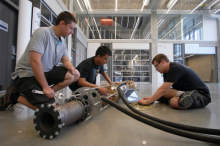If you would like to see more information on this case study, click here!
You can request this case study and a WCDE staff member will get back to you.
 The Waterloo Rocketry Team (WRT) is a student team at the University of Waterloo founded in 2011 that competes annually in the Intercollegiate Rocket Engineering Competition (IREC). At the 2012 competition, WRT competed using a liquid bipropellant rocket in the 25000 foot apogee category, meaning that the target height above the ground is 25000 feet. WRT’s liquid bipropellant rocket is the only one of its kind in the category; see Figure 1 for an image of the 2012 rocket. For the 2013 competition, WRT is looking to use an evolutionary design to build a liquid bipropellant rocket using different fuels. WRT is considering using liquid oxygen and kerosene as fuels to get a higher thrust to weight ratio than the previous rocket design, which used ethane and nitrous oxide as fuels. In order to increase the overall efficiency of the rocket, the mass must also be reduced. Therefore, it is desirable to make the tank able to provide structure for the rocket as well as containing the pressurized fuel. Special considerations must also be made for the storage of liquid oxygen, as it is stored cryogenically.
The Waterloo Rocketry Team (WRT) is a student team at the University of Waterloo founded in 2011 that competes annually in the Intercollegiate Rocket Engineering Competition (IREC). At the 2012 competition, WRT competed using a liquid bipropellant rocket in the 25000 foot apogee category, meaning that the target height above the ground is 25000 feet. WRT’s liquid bipropellant rocket is the only one of its kind in the category; see Figure 1 for an image of the 2012 rocket. For the 2013 competition, WRT is looking to use an evolutionary design to build a liquid bipropellant rocket using different fuels. WRT is considering using liquid oxygen and kerosene as fuels to get a higher thrust to weight ratio than the previous rocket design, which used ethane and nitrous oxide as fuels. In order to increase the overall efficiency of the rocket, the mass must also be reduced. Therefore, it is desirable to make the tank able to provide structure for the rocket as well as containing the pressurized fuel. Special considerations must also be made for the storage of liquid oxygen, as it is stored cryogenically.
Adam Klett a fourth year mechanical engineering student worked on the design of the fuel tanks as his fourth year design project.
This case study is intended to be used in multiple courses in the mechanical engineering curriculum. This case can be used in ME 230, ME 235 as an example of where ductile to brittle transition temperature must be considered in materials selection. This case can also be used in ME 220 to provide an example of a pressure vessel that will also be subjected to structural loads, it provides an open ended problem for combined stresses, and allows students to reflect on ME 230 for appropriate materials selection. This case can also be used in ME 353 to illustrate heat and mass transfer used in design.
If you would like to see more information on this case study, click here!
You can request this case study and a WCDE staff member will get back to you.
Contact Waterloo Cases in Design Engineering
Steve Lambert
Tel: (519) 888-4728
Email: steve@uwaterloo.ca
The University of Waterloo acknowledges that much of our work takes place on the traditional territory of the Neutral, Anishinaabeg and Haudenosaunee peoples. Our main campus is situated on the Haldimand Tract, the land granted to the Six Nations that includes six miles on each side of the Grand River. Our active work toward reconciliation takes place across our campuses through research, learning, teaching, and community building, and is co-ordinated within the Office of Indigenous Relations.